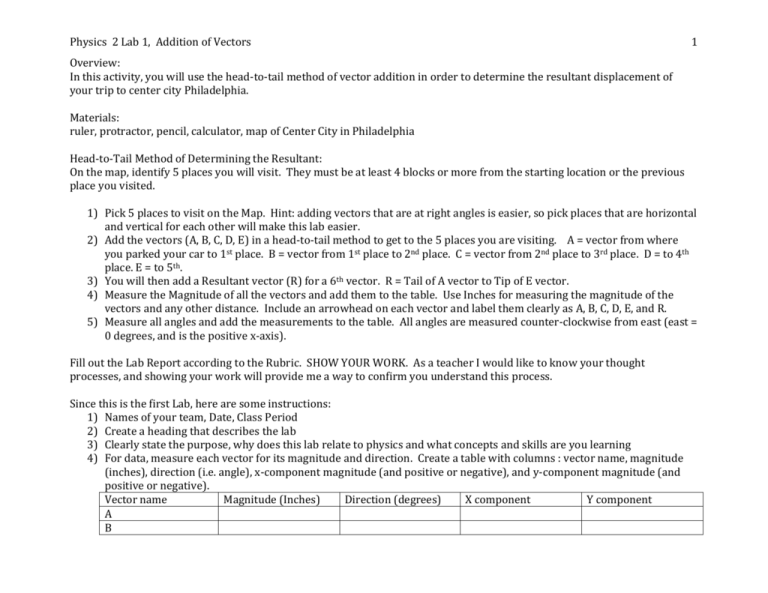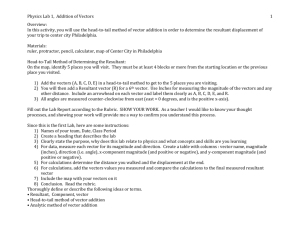Physics 2 Lab 1, Addition of Vectors Overview: In this activity, you
advertisement

Physics 2 Lab 1, Addition of Vectors 1 Overview: In this activity, you will use the head-to-tail method of vector addition in order to determine the resultant displacement of your trip to center city Philadelphia. Materials: ruler, protractor, pencil, calculator, map of Center City in Philadelphia Head-to-Tail Method of Determining the Resultant: On the map, identify 5 places you will visit. They must be at least 4 blocks or more from the starting location or the previous place you visited. 1) Pick 5 places to visit on the Map. Hint: adding vectors that are at right angles is easier, so pick places that are horizontal and vertical for each other will make this lab easier. 2) Add the vectors (A, B, C, D, E) in a head-to-tail method to get to the 5 places you are visiting. A = vector from where you parked your car to 1st place. B = vector from 1st place to 2nd place. C = vector from 2nd place to 3rd place. D = to 4th place. E = to 5th. 3) You will then add a Resultant vector (R) for a 6th vector. R = Tail of A vector to Tip of E vector. 4) Measure the Magnitude of all the vectors and add them to the table. Use Inches for measuring the magnitude of the vectors and any other distance. Include an arrowhead on each vector and label them clearly as A, B, C, D, E, and R. 5) Measure all angles and add the measurements to the table. All angles are measured counter-clockwise from east (east = 0 degrees, and is the positive x-axis). Fill out the Lab Report according to the Rubric. SHOW YOUR WORK. As a teacher I would like to know your thought processes, and showing your work will provide me a way to confirm you understand this process. Since this is the first Lab, here are some instructions: 1) Names of your team, Date, Class Period 2) Create a heading that describes the lab 3) Clearly state the purpose, why does this lab relate to physics and what concepts and skills are you learning 4) For data, measure each vector for its magnitude and direction. Create a table with columns : vector name, magnitude (inches), direction (i.e. angle), x-component magnitude (and positive or negative), and y-component magnitude (and positive or negative). Vector name Magnitude (Inches) Direction (degrees) X component Y component A B Physics 2 Lab 1, Addition of Vectors C D E R 5) For calculations determine the distance you walked and the displacement at the end. 6) For calculations, add the vectors values you measured and compare the calculations to the final measured resultant vector 7) Include the map with your vectors on it 8) Conclusion. Read the rubric. Thoroughly define or describe the following ideas or terms. • Resultant, Component, vector • Head-to-tail method of vector addition • Analytic method of vector addition 2 Physics 2 Lab 1, Addition of Vectors 3






